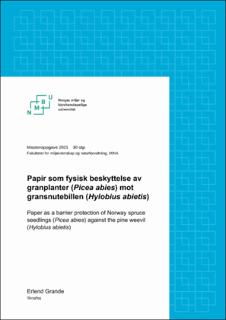| dc.contributor.advisor | Nybakken, Line | |
| dc.contributor.advisor | Asplund, Johan | |
| dc.contributor.advisor | Fløistad, Inger Sundheim | |
| dc.contributor.author | Grande, Erlend | |
| dc.coverage.spatial | Norway | en_US |
| dc.date.accessioned | 2021-09-21T12:41:29Z | |
| dc.date.available | 2021-09-21T12:41:29Z | |
| dc.date.issued | 2021 | |
| dc.identifier.uri | https://hdl.handle.net/11250/2779906 | |
| dc.description.abstract | En vellykket foryngelse er viktig for å sikre en bærekraftig skogforvaltning. Foryngelse av gran (Picea abies) foregår i all hovedsak gjennom planting. Gransnutebillen (Hylobius abietis) utgjør en stor fare for granplanter da den gnager i barken på plantene. Gnag fra gransnutebillen kan redusere plantenes vekst, og i verste fall føre til at plantene dør. Tiltak som markberedning, utsatt plantetidspunkt og utplanting av kraftige planter kan redusere dødeligheten på grunn av gransnutebillen. I tillegg til forebyggende tiltak som kan gjøres ute i felt kan plantene behandles med insekticider, men dette medfører ulike miljøproblemer. Som et alternativ til insekticider kan plantene beskyttes med en fysisk beskyttelse slik at snutebillen ikke får tilgang til plantestammen. I Norge i dag er en voksbelegning på plantestammen den vanligste formen for fysisk beskyttelse, men plantene kan også beskyttes med en barriere slik at snutebillen ikke kommer inn til planten. Formålet med denne oppgaven var å se på hvordan papir fungerte som en fysisk beskyttelse av granplanter mot gransnutebillen, og om denne beskyttelsen hadde noen negativ effekt i løpet av første sesong i felt for plantetypen M95 og M60. | en_US |
| dc.description.abstract | Successful rejuvenation is important to ensure sustainable forest management. Rejuvenation of Norway spruce (Picea abies) is usually done by planting. The pine weevil (Hylobius abietis) is a spruce pest that feeds on plant bark. Feeding from the pine weevil can reduce the plant growth, and in the worst-case lead to death. Preparations such as soil scarification, late planting and planting of large seedlings can reduce the risk of plants dying due to pine weevils. In addition to preparations in the field, the plants can be treated with insecticides, but this cause environmental problems. As an alternative to insecticides, the plants can be protected with a physical feeding barrier. In Norway today, a wax coating on the plant stem is the most common feeding barrier protection, but the plants can also be protected with a shield around the plant. The aim of this thesis was to look at how paper worked as a feeding barrier against the pine weevil, and whether this protection had any negative effects on the plants during the first growing season in the field for the plant types M95 and M60. | en_US |
| dc.language.iso | nob | en_US |
| dc.publisher | Norwegian University of Life Sciences, Ås | en_US |
| dc.rights | Attribution-NonCommercial-NoDerivatives 4.0 Internasjonal | * |
| dc.rights.uri | http://creativecommons.org/licenses/by-nc-nd/4.0/deed.no | * |
| dc.title | Papir som fysisk beskyttelse av granplanter (Picea abies) mot gransnutebillen (Hylobius abietis) | en_US |
| dc.title.alternative | Paper as a barrier protection of Norway spruce seedlings (Picea abies) against the pine weevil (Hylobius abietis) | en_US |
| dc.type | Master thesis | en_US |
| dc.description.localcode | M-SF | en_US |

